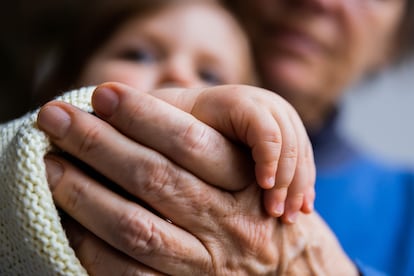Families are shrinking, thinning out, and becoming more vertical
Children born now will meet most of their great-grandparents but won’t have many siblings or cousins and most women will die alone

All around the world, families are shrinking. A girl born in 2024 will have hardly any siblings or cousins. At the same time, families are becoming increasingly vertical, so she will know all her grandparents and most of her great-grandparents. If current trends continue, that child herself will only have one child or perhaps not any children at all. By the time she is 35, her kinship network will be the smallest in modern times. And when she passes away, at a ripe old age, she will probably die alone. According to a recent study, such are the consequences of the dynamics that demographers have been observing and have projected between now and the end of the century. The researchers do not doubt that the family — no matter how different it may be in the future — will continue to perform the functions of shelter and support that it has been fulfilling since the beginning of human evolution. But they add that it is necessary to strengthen the institutions and functions of public assistance where they exist and, in most countries, to begin to build them up.
Understood as the kinship network consisting of the number of living great-grandparents, grandparents, parents, children, grandchildren and great-grandchildren, as well as aunts, uncles, cousins and nephews and nieces, family size has been shrinking steadily since 1950. According to recent research published in the scientific journal PNAS, a woman who was 65 years old in the middle of the last century had 41 relatives on average worldwide. Barely 150 years later, in 2095, another woman of that same age will only have 25 relatives.
Sometimes, mathematical averages confuse more than they clarify, and that is the case here. The global average obscures the depth of the changes that the family is undergoing in most places. Countries have not followed the same trends worldwide: the most developed societies have already made their classic demographic transition (from high birth and mortality rates to low birth and mortality rates), while many other nations are at different stages of that revolution. Some countries — like Japan, Italy and Spain — seem to have entered a kind of post-transition. Two examples clearly illustrate the distortion of averages: in 1950, a woman who reached the age of 65 in Zimbabwe had numerous relatives to take care of her: 82 people, including siblings, cousins, children, grandchildren, nieces and nephews... even one or two grandparents. In 2095, the oldest Zimbabweans will have a dwindling family of just 24 members. The Italian case is at the opposite extreme of this process. As a country that has already completed its own demographic transition, the decrease in Italy is smaller: an Italian nonna in the mid-20th century had 18 relatives, a figure that will drop to 12.7 by the end of this century.
A comparison between two countries shows the same trends: a Spanish woman who reached retirement in 1950 had a family of 21 people. In 2095, that number will decrease nearly by half (12.9 relatives). However, the Mexican case follows the Zimbabwean case: grandmothers in the middle of the last century enjoyed a very extensive kinship network of 67 relatives. But by the end of this century, Mexico will look more like Spain, with families consisting of 18.9 members, including the 65-year-old birthday girl. According to the recently published research led by Diego Alburez, a demographer at the Max Planck Institute for Demographic Research (MPIDR, in Germany), this is a worldwide trend. Families in the global south had 31 more relatives at the beginning of the period studied than those in the most developed countries. That gap will narrow to 20 by the end of the century.
Lateral kinship is going to change. The number of siblings, cousins, aunts, uncles, nieces and nephews will decreaseDiego Alburez, a researcher at the Max Planck Institute for Demographic Research in Germany.
Alburez notes that this family shrinkage is not only quantitative; specifically, the family is thinning at the flanks. “What we call lateral kinship is going to change. The number of siblings, cousins, aunts, uncles and nieces and nephews is going to decrease,” he says. At the same time, he adds, “we’re going to be seeing increasingly more intergenerational families, with more elders and more age difference between relatives.” This is what demographers call the “transition from the horizontal to the vertical family.” According to this study, the distance between newborn members of a family nucleus and the oldest relatives has continued to increase. China is the most extreme case; there, the process resembles chewing gum that keeps stretching. In the 1950s, in the newly created People’s Republic of China, girls were born with numerous cousins (11). In 2095, the effects of China’s draconian one-child policy imposed by the communist regime between 1982 and 2015 to control the population explosion will continue to be felt: a Chinese woman born at the end of the century will have only 1.1 cousins. However, she will know her four grandparents and up to six of her great-grandparents — almost twice as many as those born under the regime of Mao Zedong, the father of modern China.
China is at the extreme end of a global trend: families are lengthening to the point that it will be common for great-grandchildren and great-grandparents to meet and overlap for several years, which has been rare in modern societies. That will pose new problems. Alburez, who leads a group at MPIDR researching kinship inequalities, has been working on the concept of the sandwich generation for years. With infant mortality falling and life expectancy rising first, and fertility falling and childbearing delayed, the generations around 35-50 years of age, especially women, sustain the whole system.
“To the extent that members of different generations are alive at the same time, we may have a father and a grandmother, and that grandmother’s own parents may still be alive, elders who also have a grandchild. The sum total of demands for attention and care experienced by [middle-aged] people is going to increase,” Alburez says. The idea of the “sandwich generation” comes from sociology. The basic concept was originally developed in the U.S. at the historical moment when women entered the labor market in massive numbers (as was the case in World War II). “At the same time that people were living longer, they were having children at an older age, which caused this generation of women to work while also continuing to provide care for their families,” he says.
A quarter of women born in the 1970s have not had children. Among men, up to 30% are childlessClara Cortina, a researcher at DemoSoc at Pompeu Fabra University in Spain
In biological kinship networks, there are new realities that complicate the work of demographers and their sketches of the future family. One of the most dramatic changes is the growing number of people of childbearing age who do not have children. For now, that trend is limited to the most developed countries, but where it exists it is a very marked one. Clara Cortina, a researcher at Pompeu Fabra University’s Sociodemographic Research Group (DemoSoc), offers two convincing facts: “A quarter of women born in the 1970s have not had children [and biologically will no longer be able to have them]. The percentage of childless men is even higher, up to 30%. We still don’t know what will happen with the next generation, the 1980s generation,″ she says. In three decades, when they approach the end of their lives, perhaps they will have a sibling or niece or nephew nearby, but most likely they will not have anyone.
Although no studies have been done on the connection between this childless generation and their life satisfaction as they reach old age (it hasn’t been done because they haven’t reached it yet), Cortina did participate in work such as the SHARE project, a survey of health, aging and retirement in Europe. Here, the case of single men and women in earlier periods could serve as an analogue for those who have decided to remain childless today. “In the past, networks of siblings and friends filled the gap. But we don’t know if this will continue to work in the future,” she says. For their part, homoparental families barely represent just over 1% of all couples. Leaving aside the specific issue of gay men’s marriages, “the fertility of lesbian women is somewhat lower; they tend to have fewer children. It is still more complicated for them to become mothers,” Cortina observes.
Immigration is another factor that is diversifying the idea of family. In Spain, immigrants account for just over 13%, but the vast majority are young and could not bring their parents with them, so there are no grandparents. Cortina also mentions another element that Alburez’s work did not include: “Another layer of complexity must be added to kinship networks. In addition to biological relatives, we must add new members who are incorporated when a divorced person remarries and the new partner brings their own children into the family.” Part of this new reality is that more children were born to single mothers than to married mothers last year.
Teresa Castro, of the Institute of Economics, Geography and Demography (IEGD-CSIC), maintains that the family is always changing, but she agrees that it is on the path to lower numbers of children, an increase in verticality and a greater difference in the ages between generations. “Children are going to be favored, with all their grandparents and the occasional great-grandparent,” she says half-jokingly. “For the elderly, the situation is quite different: they will have fewer and fewer potential caregivers,” she adds. Looking ahead, the care that the family can no longer provide is perhaps the most significant impact. “The elderly no longer expect their children to take care of them,” Castro concludes. In societies like Spain’s, with public institutions and private companies taking over, it will not be an issue. But in other societies without state and private initiatives, that care is not within everyone’s reach. Even so, Castro is convinced that “regardless of what changes the family undergoes, solidarity, affection and family ties will remain.”
Sign up for our weekly newsletter to get more English-language news coverage from EL PAÍS USA Edition
Tu suscripción se está usando en otro dispositivo
¿Quieres añadir otro usuario a tu suscripción?
Si continúas leyendo en este dispositivo, no se podrá leer en el otro.
FlechaTu suscripción se está usando en otro dispositivo y solo puedes acceder a EL PAÍS desde un dispositivo a la vez.
Si quieres compartir tu cuenta, cambia tu suscripción a la modalidad Premium, así podrás añadir otro usuario. Cada uno accederá con su propia cuenta de email, lo que os permitirá personalizar vuestra experiencia en EL PAÍS.
¿Tienes una suscripción de empresa? Accede aquí para contratar más cuentas.
En el caso de no saber quién está usando tu cuenta, te recomendamos cambiar tu contraseña aquí.
Si decides continuar compartiendo tu cuenta, este mensaje se mostrará en tu dispositivo y en el de la otra persona que está usando tu cuenta de forma indefinida, afectando a tu experiencia de lectura. Puedes consultar aquí los términos y condiciones de la suscripción digital.
More information
Últimas noticias
Most viewed
- David King, chemist: ‘There are scientists studying how to cool the planet; nobody should stop these experiments from happening’
- Reinhard Genzel, Nobel laureate in physics: ‘One-minute videos will never give you the truth’
- Mexico completes its trade shift with the entry into force of tariffs on China and countries without trade agreements
- Oona Chaplin: ‘I told James Cameron that I was living in a treehouse and starting a permaculture project with a friend’
- Sinaloa Cartel war is taking its toll on Los Chapitos











































